Evaluation of Three High-Resolution Remote Sensing Precipitation Products on the Tibetan Plateau
Abstract
:1. Introduction
2. Materials and Methods
2.1. Study Area
2.2. Data
3. Methods
3.1. Data Processing
3.2. Evaluation Index System
4. Results
4.1. Evaluation of Precipitation Products at Annual and Monthly Scales
4.2. Daily Precipitation Capturing Capacity and Distribution
4.3. Regional Differences and Proportion of Evaluation Points with Different Precisions
5. Conclusions and Discussion
- For all three products, the correlation was always higher at the monthly scale than at the annual scale, with the correlation in December being the lowest among all months. The correlations at the annual scale, at the monthly scale and in December of GPM were higher than those of the other products. In general, GPM performed best at both the annual and monthly scales, followed by TRMM and CMORPH;
- GPM had the best detection accuracy for both precipitation and non-precipitation events, while TRMM and CMORPH had comparable capturing capabilities. The three products overestimated 0.1~1 mm/day precipitation, which occurred most frequently; underestimated precipitation at 10~20 mm/day, which contributed the largest proportion for precipitation of the TP; and underestimate the annual maximum daily precipitation;
- Compared with TRMM and CMORPH, GPM had higher CC in the southeast, higher PODrain in the south, higher HSS in the southern and central–eastern regions, and lower MAR in the southern part of the TP. The mean values of CC, BIAS, PODrain, PODnorain, FARrain, FARnorain, POFD, MAR and HSS of all stations showed that GPM had the best performance among the three products.
Author Contributions
Funding
Conflicts of Interest
References
- Elhamid, A.M.; Eltahan, A.M.; Mohamed, L.M.; Hamouda, I.A. Assessment of the two satellite-based precipitation products TRMM and RFE rainfall records using ground based measurements. Alex. Eng. J. 2020, 59, 1049–1058. [Google Scholar] [CrossRef]
- Ren, M.; Xu, Z.; Pang, B.; Liu, W.; Liu, J.; Du, L.; Wang, R. Assessment of Satellite-Derived Precipitation Products for the Beijing Region. Remote Sens. 2018, 10, 1914. [Google Scholar] [CrossRef] [Green Version]
- Hou, A.Y.; Kakar, R.K.; Neeck, S.; Azarbarzin, A.A.; Kummerow, C.D.; Kojima, M.; Oki, R.; Nakamura, K.; Iguchi, T. The global precipitation measurement mission. Bull. Am. Meteorol. Soc. 2014, 95, 701–722. [Google Scholar] [CrossRef]
- Zhang, C.; Chen, X.; Shao, H.; Chen, S.; Liu, T.; Chen, C.; Ding, Q.; Du, H. Evaluation and Intercomparison of High-Resolution Satellite Precipitation Estimates-GPM, TRMM, and CMORPH in the Tianshan Mountain Area. Remote Sens. 2018, 10, 1543. [Google Scholar] [CrossRef] [Green Version]
- Fallah, A.; Oh, S.; Orth, R. Climate-Dependent Propagation of Precipitation Uncertainty into the Water Cycle. Hydrol. Earth Syst. Sci. 2020, 24, 3725–3735. [Google Scholar] [CrossRef]
- Wang, C.; Hong, Y. Review on Inversion, Verification and Application of Satellite Remote Sensing of Precipitation. Water Resour. Hydropower Eng. 2018, 49, 1–9. [Google Scholar]
- Xiong, L.; Liu, C.; Cheng, S.; Zha, X.; Ma, Q. Review of Post-Processing Research for Remote-Sensing Precipitation Products. Adv. Water Sci. 2021, 32, 627–637. [Google Scholar]
- Huffman, G.J.; Bolvin, D.T.; Nelkin, E.J.; Wolff, D.B.; Adler, R.F.; Gu, G.; Hong, Y.; Bowman, K.P.; Stocker, E.F. The TRMM Multisatellite Precipitation Analysis (TMPA): Quasi-Global, Multiyear, Combined-Sensor Precipitation Estimates at Fine Scales. J. Hydrometeorol. 2007, 8, 38–55. [Google Scholar] [CrossRef]
- Skofronick-Jackson, G.; Petersen, W.A.; Berg, W.; Kidd, C.; Stocker, E.F.; Kirschbaum, D.B.; Kakar, R.; Braun, S.A.; Huffman, G.J.; Iguchi, T.; et al. The Global Precipitation Measurement (GPM) Mission for Science and Society. Bull. Am. Meteorol. Soc. 2017, 98, 1679–1695. [Google Scholar] [CrossRef]
- Joyce, R.J.; Janowiak, J.E.; Arkin, P.A.; Xie, P. CMORPH: A Method That Produces Global Precipitation Estimates from Passive Microwave and Infrared Data at High Spatial and Temporal Resolution. J. Hydrometeorol. 2004, 5, 487–503. [Google Scholar] [CrossRef]
- Hsu, K.-L.; Gao, X.; Sorooshian, S.; Gupta, H.V. Precipitation Estimation from Remotely Sensed Information Using Artificial Neural Networks. J. Appl. Meteorol. 1997, 36, 1176–1190. [Google Scholar] [CrossRef]
- Okamoto, K.; Ushio, T.; Iguchi, T.; Takahashi, N.; Iwanami, K. The Global Satellite Mapping of Precipitation (GSMaP) Project. In Proceedings of the International Geoscience and Remote Sensing Symposium (IGARSS), Seoul, Korea, 29 July 2005; Volume 5, pp. 3414–3416. [Google Scholar]
- Derin, Y.; Anagnostou, E.; Berne, A.; Borga, M.; Boudevillain, B.; Buytaert, W.; Chang, C.-H.; Delrieu, G.; Hong, Y.; Hsu, Y.C.; et al. Multiregional Satellite Precipitation Products Evaluation over Complex Terrain. J. Hydrometeorol. 2016, 17, 1817–1836. [Google Scholar] [CrossRef]
- Wang, H.; Yuan, Y.; Zeng, S.; Li, W.; Tang, X. Evaluation of Satellite-Based Precipitation Products from GPM IMERG and GSMaP over the Three-River Headwaters Region, China. Hydrol. Res. 2021, 52, 1328–1343. [Google Scholar] [CrossRef]
- Peng, Z.; Li, Y.; Yu, W.; Xing, Y.; Feng, A. Research on the Applicability of Remote Sensing Precipitation Products in Different Climatic Regions of China. J. Geo-Inf. Sci. 2021, 23, 1296–1311. [Google Scholar]
- Tan, M.L.; Ibrahim, A.L.; Duan, Z.; Cracknell, A.P.; Chaplot, V. Evaluation of Six High-Resolution Satellite and Ground-Based Precipitation Products over Malaysia. Remote Sens. 2015, 7, 1504–1528. [Google Scholar] [CrossRef] [Green Version]
- Yu, L.; Ma, L.; Li, H.; Zhang, Y.; Kong, F.; Yang, Y. Assessment of high-resolution satellite rainfall products over a gradually elevating mountainous terrain based on a high-density rain gauge network. Int. J. Remote Sens. 2020, 41, 5620–5644. [Google Scholar] [CrossRef]
- Peng, F.; Zhao, S.; Chen, C.; Cong, D.; Wang, Y.; Ouyang, H. Evaluation and comparison of the precipitation detection ability of multiple satellite products in a typical agriculture area of China. Atmos. Res. 2020, 236, 104814. [Google Scholar] [CrossRef]
- Liu, J.; Shangguan, D.; Liu, S.; Ding, Y.; Wang, S.; Wang, X. Evaluation and Comparison of CHIRPS and MSWEP Daily-Precipitation Products in the Qinghai-Tibet Plateau during the Period of 1981–2015. Atmos. Res. 2019, 230, 104634. [Google Scholar] [CrossRef]
- Duan, Z.; Liu, J.; Tuo, Y.; Chiogna, G.; Disse, M. Evaluation of eight high spatial resolution gridded precipitation products in Adige Basin (Italy) at multiple temporal and spatial scales. Sci. Total Environ. 2016, 573, 1536–1553. [Google Scholar] [CrossRef] [Green Version]
- Hosseini-Moghari, S.-M.; Tang, Q. Validation of GPM IMERG V05 and V06 Precipitation Products over Iran. J. Hydrometeorol. 2020, 21, 1011–1037. [Google Scholar] [CrossRef] [Green Version]
- Li, G.; Yu, Z.; Wang, W.; Ju, Q.; Chen, X. Analysis of the spatial Distribution of precipitation and topography with GPM data in the Tibetan Plateau. Atmos. Res. 2021, 247, 105259. [Google Scholar] [CrossRef]
- Wang, S.; Liu, J.; Wang, J.; Qiao, X.; Zhang, J. Evaluation of GPM IMERG V05B and TRMM 3B42V7 Precipitation Products over High Mountainous Tributaries in Lhasa with Dense Rain Gauges. Remote Sens. 2019, 11, 2080. [Google Scholar] [CrossRef] [Green Version]
- Yao, T.; Chen, F.; Cui, P.; Ma, Y.; Xu, B.; Zhu, L.; Zhang, F.; Wang, W.; Ai, L.; Yang, X. From Tibetan Plateau to Third Pole and Pan-Third Pole. Bull. Chin. Acad. Sci. 2017, 32, 924–931. [Google Scholar]
- Liu, Z.; Yang, M.; Wang, X.; Cheng, L. The GPM and TRMM Satellite-Based Precipitation Products Applied in the Source Regions of the Yellow River. J. Glaciol. Geocryol. 2020, 42, 575–586. [Google Scholar]
- Liu, J.; Xu, Z.; Zhao, H.; He, J. Accuracy Assessment for Two Satellite Precipitation Products: Case Studies in the Yarlung Zangbo River Basin. Plateau Meteorol. 2019, 38, 386–396. [Google Scholar]
- Lv, Y.; Yang, S.; Cai, M.; Zhou, Q.; Dong, G. The Applicability Analysis of TRMM Precipitation Data in the Yarlung Zangbo River Basin. J. Nat. Resour. 2013, 28, 1414–1425. [Google Scholar]
- Zhang, M.; Huang, A.; Ji, X.; Wang, M.; Tan, Y. Validation of Satellite Precipitation Products over Qinghai-Xizang Plateau Region. Plateau Meteorol. 2016, 35, 34–42. [Google Scholar]
- Jiang, X.; Liu, Y.; Wu, Y.; Wang, G.; Wu, W.; Jin, J.; He, R.; Liu, C. Research on the Quality Evaluation of GPM Satellite Precipitation Data Products Taking the Yarlung Zangbo River as an Example. China Rural Water Hydropower 2021, 6, 91–97. [Google Scholar]
- Yu, K.; Zhang, Y.; Ma, N.; Guo, Y. Applicability of GPM and TRMM Remote Sensing Precipitation Products in the Central Tibet Plateau. Arid Zone Res. 2018, 35, 1373–1381. [Google Scholar]
- Shen, Y.; Xiong, A.; Wang, Y.; Xie, P. Performance of High-Resolution Satellite Precipitation Products over China. J. Geophys. Res. Atmos. 2010, 115, D2. [Google Scholar] [CrossRef]
- Qin, Y.; Chen, Z.; Shen, Y.; Zhang, S.; Shi, R. Evaluation of Satellite Rainfall Estimates over the Chinese Mainland. Remote Sens. 2014, 6, 11649–11672. [Google Scholar] [CrossRef] [Green Version]
- Bai, P.; Liu, X. Evaluation of Five Satellite-Based Precipitation Products in Two Gauge-Scarce Basins on the Tibetan Plateau. Remote Sens. 2018, 10, 1316. [Google Scholar] [CrossRef] [Green Version]
- Wang, G.; Zhang, P.; Liang, L.; Zhang, S. Evaluation of precipitation from CMORPH, GPCP-2, TRMM 3B43, GPCC, and ITPCAS with ground-based measurements in the Qinling-Daba Mountains, China. PLoS ONE 2017, 12, e0185147. [Google Scholar]
- Tan, M.L.; Duan, Z. Assessment of GPM and TRMM Precipitation Products over Singapore. Remote Sens. 2017, 9, 720. [Google Scholar] [CrossRef] [Green Version]
- Yan, D.; Liu, S.; Qin, T.; Weng, B.; Li, C.; Lu, Y.; Liu, J. Evaluation of TRMM Precipitation and Its Application to Distributed Hydrological Model in Naqu River Basin of the Tibetan Plateau. Hydrol. Res. 2017, 48, 822–839. [Google Scholar] [CrossRef] [Green Version]
- Xu, F.; Guo, B.; Ye, B.; Ye, Q.; Chen, H.; Ju, X.; Guo, J.; Wang, Z. Systematical Evaluation of GPM IMERG and TRMM 3B42V7 Precipitation Products in the Huang-Huai-Hai Plain, China. Remote Sens. 2019, 11, 697. [Google Scholar] [CrossRef] [Green Version]
- Zhang, Y.; Li, B.; Liu, L.; Zheng, D. Redetermine the Region and Boundaries of Tibetan Plateau. Geogr. Res. 2021, 40, 1543–1553. [Google Scholar]
- Zhang, Y.; Li, B.; Zheng, D. A Discussion on the Boundary and Area of the Tibetan Plateau in China. Geogr. Res. 2002, 21, 1–8. [Google Scholar]
- Zhang, Y.; Ren, H.; Pan, X. Integration Dataset of Tibet Plateau Boundary. Available online: https://data.tpdc.ac.cn/en/data/61701a2b-31e5-41bf-b0a3-607c2a9bd3b3/ (accessed on 3 June 2022).
- Liu, Z.; Yang, M.; Wan, G.; Wang, X. The Spatial and Temporal Variation of Temperature in the Qinghai-Xizang (Tibetan) Plateau during 1971–2015. Atmosphere 2017, 8, 214. [Google Scholar] [CrossRef] [Green Version]
- Wan, G.; Yang, M.; Liu, Z.; Wang, X.; Liang, X. The Precipitation Variations in the Qinghai-Xizang (Tibetan) Plateau during 1961–2015. Atmosphere 2017, 8, 80. [Google Scholar] [CrossRef] [Green Version]
- Li, X.; Sun, Y. Accuracy Verification and Error-Component Analysis on Multi-Satellite Precipitation Products in Sichuan-Chongqing Region. Yangtze River 2022, 53, 97–103. [Google Scholar]
- New, M.; Todd, M.; Hulme, M.; Jones, P. Precipitation Measurements and Trends in the Twentieth Century. Int. J. Climatol. 2001, 21, 1889–1922. [Google Scholar] [CrossRef]
- Xie, P.; Arkin, P.A. Global Precipitaion: A 17-Year Monthly Analysis Based on Gauge Observations, Satellite Estimates, and Numerical Model Outputs. Bull. Am. Meteorol. Soc. 1997, 78, 2539–2558. [Google Scholar] [CrossRef]
- Hamal, K.; Sharma, S.; Khadka, N.; Baniya, B.; Ali, M.; Shrestha, M.S.; Xu, T.; Shrestha, D.; Dawadi, B. Evaluation of MERRA-2 Precipitation Products Using Gauge Observation in Nepal. Hydrology 2020, 7, 70. [Google Scholar] [CrossRef]
- Li, Z.; Yang, D.; Hong, Y. Multi-scale evaluation of high-resolution multi-sensor blended global precipitation products over the Yangtze River. J. Hydrol. 2013, 500, 157–169. [Google Scholar] [CrossRef]
- Hu, Z.; Ni, Y.; Shao, H.; Yin, G.; Yan, Y.; Jia, C. Applicability Study of CFSR, ERA-Interim and MERRA Precipitation Estimates in Central Asia. Arid Land Geogr. 2013, 36, 700–708. [Google Scholar]
- Wang, G.; Zhang, X.; Zhang, S. Performance of Three Reanalysis Precipitation Datasets over the Qinling-Daba Mountains, Eastern Fringe of Tibetan Plateau, China. Adv. Meteorol. 2019, 2019, 7698171. [Google Scholar] [CrossRef] [Green Version]
- Kumar, B.; Patra, K.C.; Lakshmi, V. Daily rainfall statistics of TRMM and CMORPH: A case for trans-boundary Gandak River basin. J. Earth Syst. Sci. 2016, 125, 919–934. [Google Scholar] [CrossRef] [Green Version]
- Li, Z. Multi-Source Precipitation Observations and Fusion for Hydrological Applications in the Yangtze River Basin. Ph.D. Thesis, Tsinghua University, Beijing, China, 2015. [Google Scholar]
- Kirstetter, P.E.; Hong, Y.; Gourley, J.J.; Chen, S.; Flamig, Z.; Zhang, J.; Schwaller, M.; Petersen, W.; Amitai, E. Toward a Framework for Systematic Error Modeling of Spaceborne Precipitation Radar with NOAA/NSSL Ground Radar–Based National Mosaic QPE. J. Hydrometeorol. 2012, 13, 1285–1300. [Google Scholar] [CrossRef]
- Chen, S.; Hong, Y.; Cao, Q.; Gourley, J.J.; Kirstetter, P.E.; Yong, B.; Tian, Y.; Zhang, Z.; Shen, Y.; Hu, J.; et al. Similarity and Difference of the Two Successive V6 and V7 TRMM Multisatellite Precipitation Analysis Performance over China. J. Geophys. Res. Atmos. 2013, 118, 13060–13074. [Google Scholar] [CrossRef]
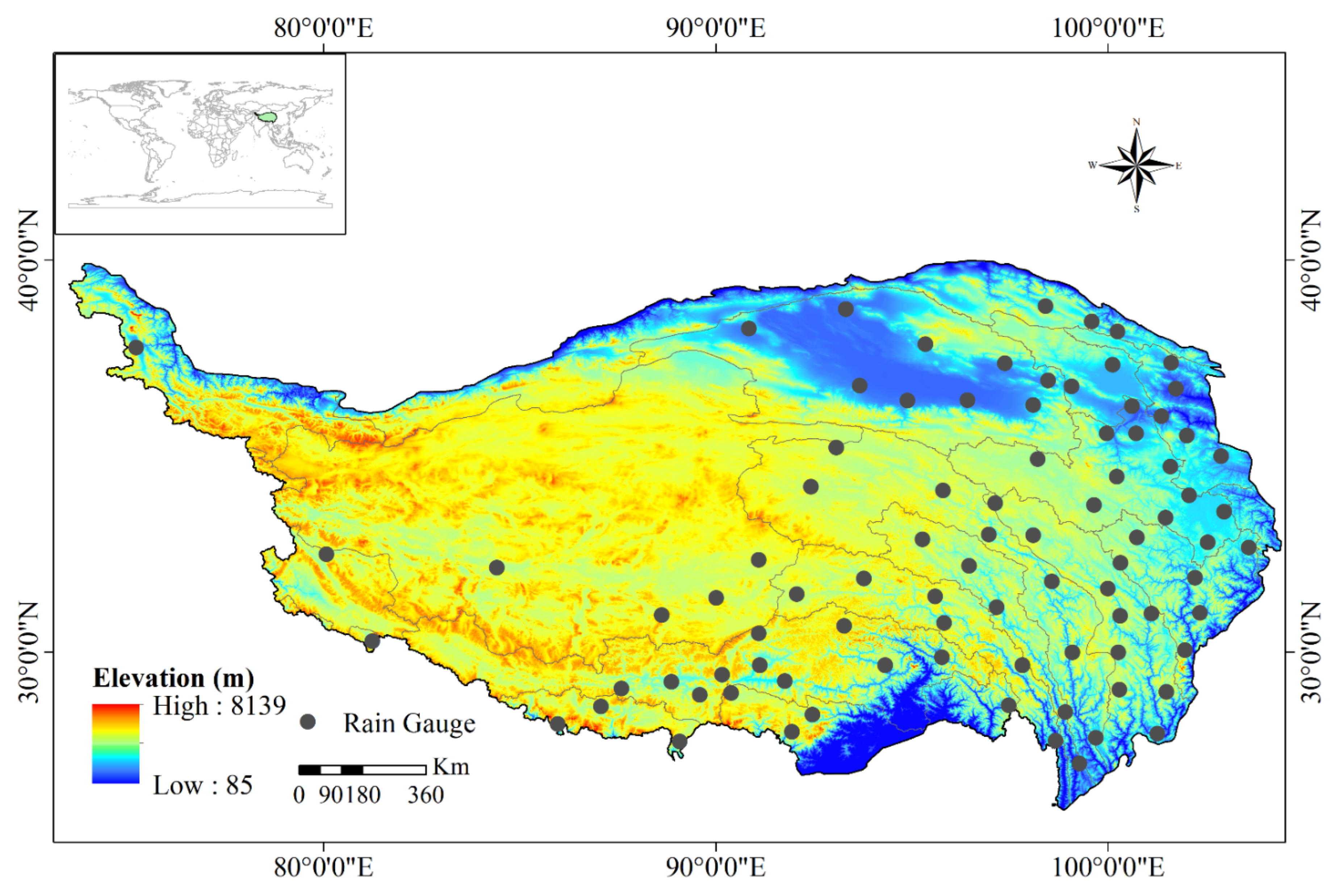
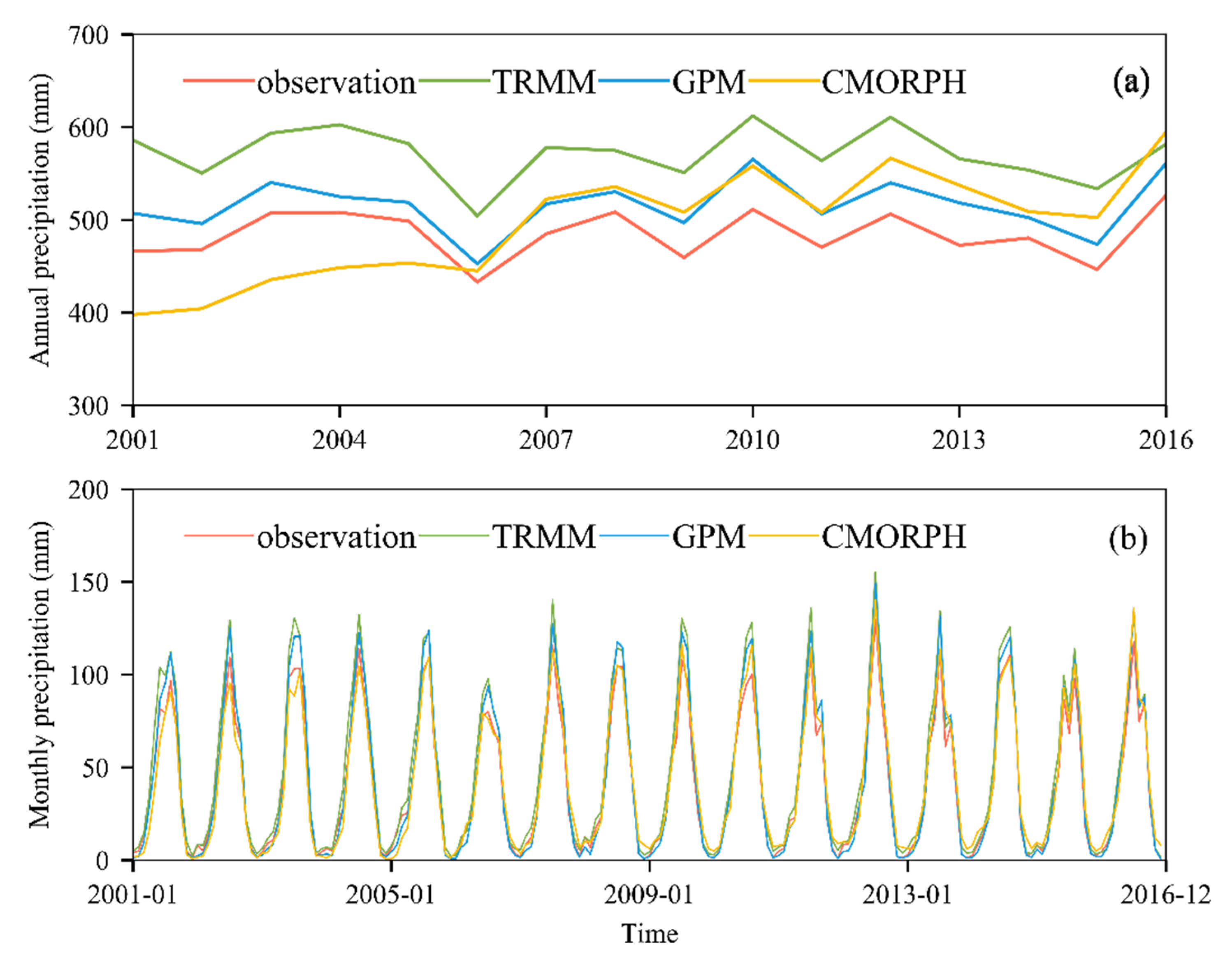
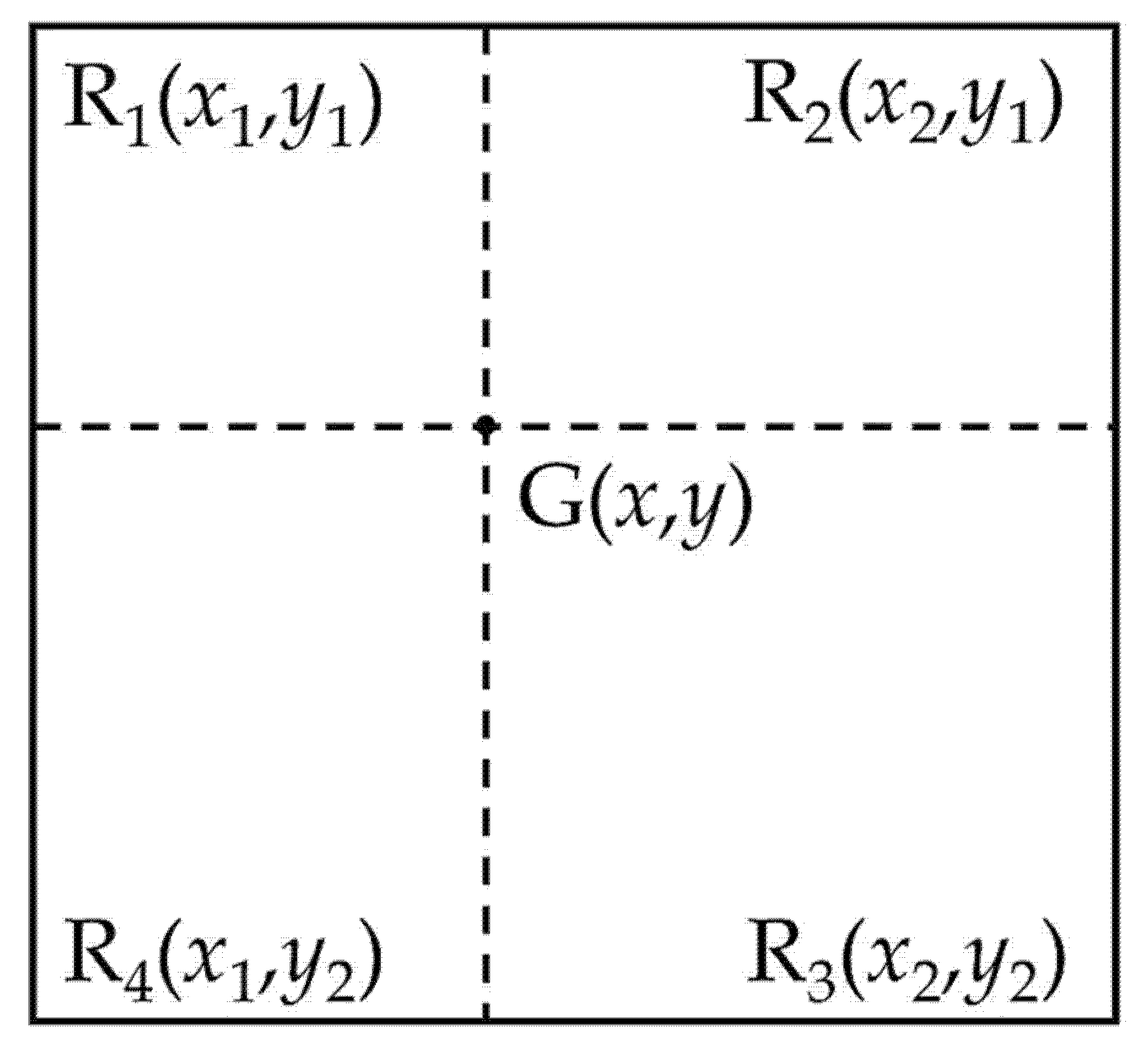


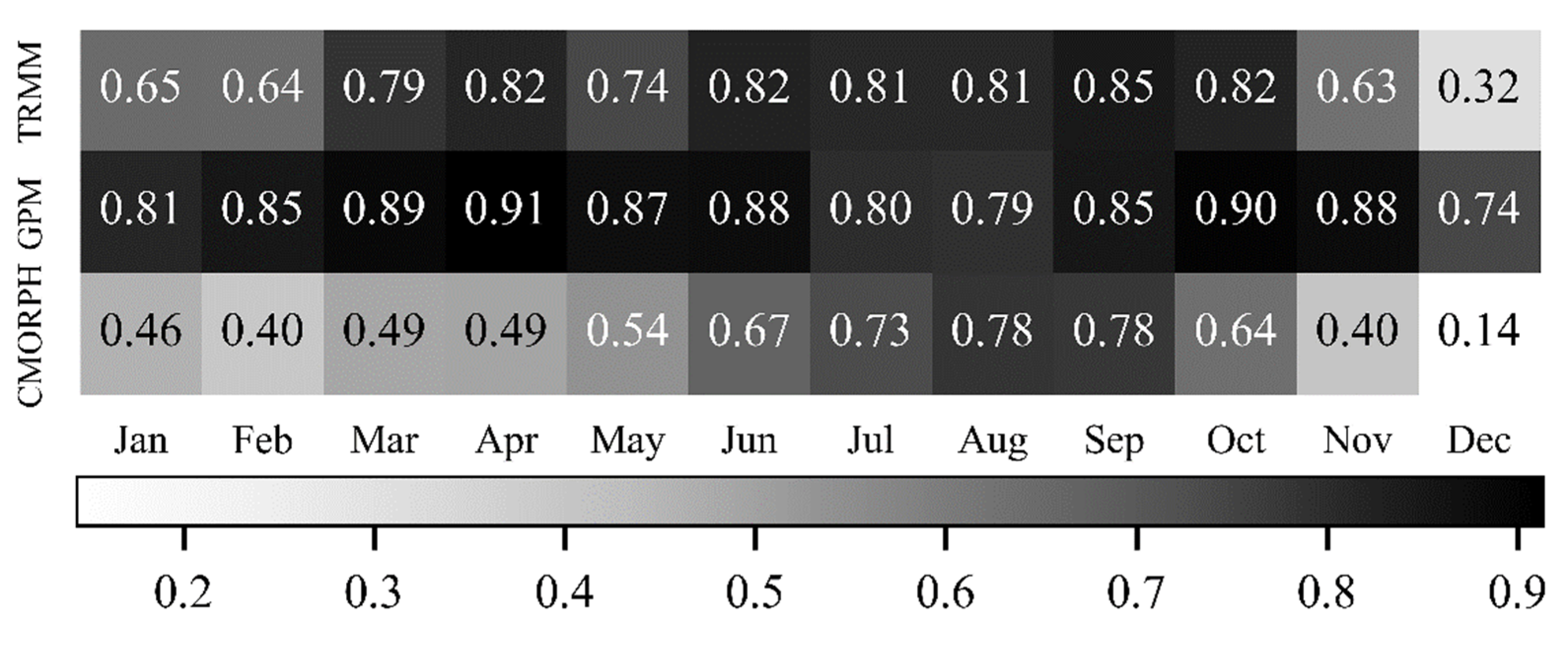
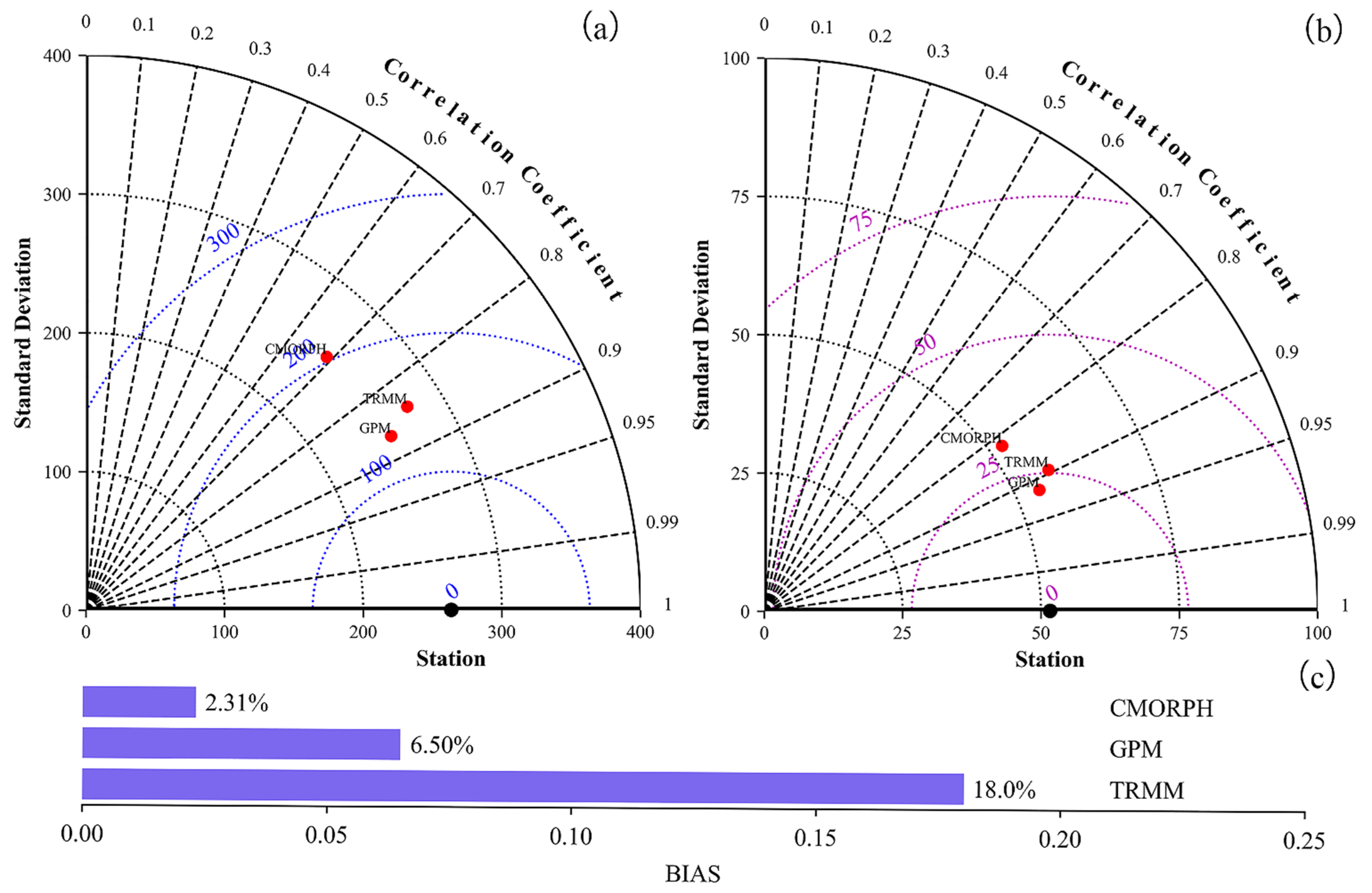

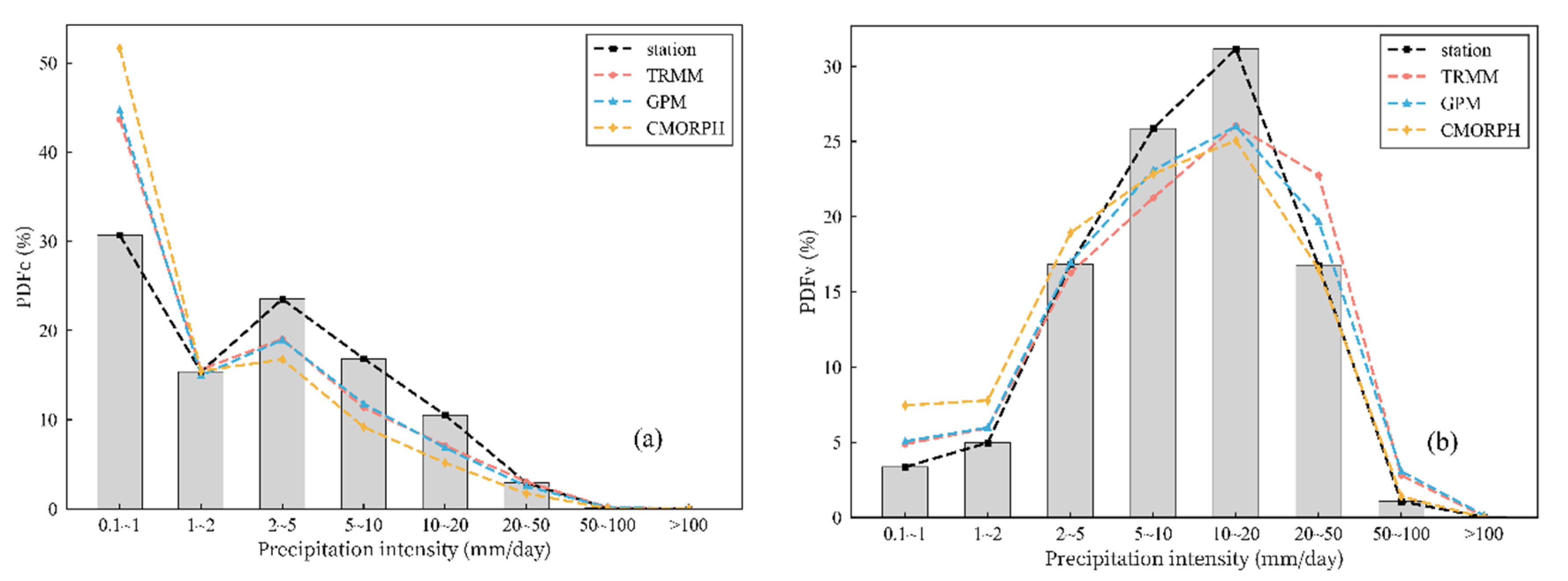



| Evaluation Index | Equation | Number |
|---|---|---|
| Correlation coefficient (CC) | (1) | |
| Relative bias (BIAS) | (2) | |
| Root-mean-square error (RMSE) | (3) | |
| Standard deviation (SD) | (4) | |
| Probability of detection (POD) | (5) | |
| (6) | ||
| False alarm ratio (FAR) | (7) | |
| (8) | ||
| Probability of false detection (POFD) | (9) | |
| Missing alarm ratio (MAR) | (10) | |
| Heidke skill score (HSS) | (11) | |
| Probability distribution function by occurrence (PDFc) | (12) | |
| Probability distribution function by volume (PDFv) | (13) |
| Index | Division of Index Intervals | |||
|---|---|---|---|---|
| I | II | III | IV | |
| CC | <0.15 | 0.15~0.30 | 0.30~0.45 | >0.45 |
| BIAS | <0 | 0~1.5 | 1.5~3 | >3 |
| RMSE | <2.5 | 2.5~5 | 5~7.5 | >7.5 |
| PODrain | <0.25 | 0.25~0.50 | 0.50~0.75 | >0.75 |
| PODnorain | <0.7 | 0.7~0.8 | 0.8~0.9 | >0.9 |
| FARrain | <0.4 | 0.4~0.6 | 0.6~0.8 | >0.8 |
| FARnorain | <0.1 | 0.1~0.2 | 0.2~0.3 | >0.3 |
| POFD | <0.1 | 0.1~0.2 | 0.2~0.3 | >0.3 |
| MAR | <0.25 | 0.25~0.50 | 0.50~0.75 | >0.75 |
| HSS | <0.08 | 0.08~0.16 | 0.16~0.24 | >0.24 |
Publisher’s Note: MDPI stays neutral with regard to jurisdictional claims in published maps and institutional affiliations. |
© 2022 by the authors. Licensee MDPI, Basel, Switzerland. This article is an open access article distributed under the terms and conditions of the Creative Commons Attribution (CC BY) license (https://creativecommons.org/licenses/by/4.0/).
Share and Cite
Yu, S.; Lu, F.; Zhou, Y.; Wang, X.; Wang, K.; Song, X.; Zhang, M. Evaluation of Three High-Resolution Remote Sensing Precipitation Products on the Tibetan Plateau. Water 2022, 14, 2169. https://doi.org/10.3390/w14142169
Yu S, Lu F, Zhou Y, Wang X, Wang K, Song X, Zhang M. Evaluation of Three High-Resolution Remote Sensing Precipitation Products on the Tibetan Plateau. Water. 2022; 14(14):2169. https://doi.org/10.3390/w14142169
Chicago/Turabian StyleYu, Songbin, Fan Lu, Yuyan Zhou, Xiaoyu Wang, Kangming Wang, Xinyi Song, and Ming Zhang. 2022. "Evaluation of Three High-Resolution Remote Sensing Precipitation Products on the Tibetan Plateau" Water 14, no. 14: 2169. https://doi.org/10.3390/w14142169
APA StyleYu, S., Lu, F., Zhou, Y., Wang, X., Wang, K., Song, X., & Zhang, M. (2022). Evaluation of Three High-Resolution Remote Sensing Precipitation Products on the Tibetan Plateau. Water, 14(14), 2169. https://doi.org/10.3390/w14142169






